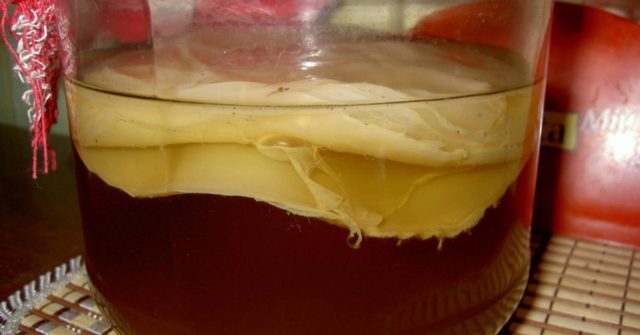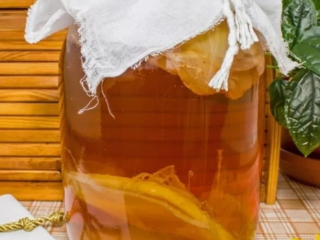Content
Medusomyces Gisevi, or kombucha, is a symbiosis of yeast fungus and acetic acid bacteria. The drink obtained with its help, called kombucha, is closest to kvass, only not bread, but tea. It’s not difficult to prepare, but the truly jellyfish-like substance needs to be looked after and kept clean. Rinsing kombucha is very simple, but many people do not know how to do it correctly. As a result, the medusomycete gets sick, and the kombucha becomes hazardous to health.
Do I need to rinse my kombucha?
Washing the kombucha is the most important stage of care. A sweet solution, drunk or containing little tea leaves, is an excellent breeding ground for any microorganisms, including pathogens. If hygiene procedures are not carried out, they will multiply in the body of the mushroom, the drink and on the walls of the vessel. Kombucha will become harmful, the medusomycete will get sick.
If the substance is not washed regularly with water, its surface will become stained and begin to deteriorate. This should not be allowed, since the drink will cease to be useful long before external signs of spoilage appear.
How to rinse kombucha
It is often recommended to wash the medusomycete under running water. But it comes from a tap, which is not very useful. This can be done, but it is highly undesirable. The correct method is a little more labor-intensive, but it allows you to maintain the health of microorganisms and get a tasty and actually healthy drink.
How often should you rinse your kombucha?
Not everyone knows how often to rinse kombucha. For hygiene procedures, an interval of 2-3 weeks is too long. If everything else is done correctly, during this time the medusomycete may not have time to get sick enough for external signs to appear and the drink to become hazardous to health. But the “work” will be worse, and the kombucha will lose some of its healing properties.
You have to wash your kombucha often – preferably after preparing each serving. Some even argue that in summer this should be done every 3 or 4 days, in winter - half as often. But you cannot remove the substance from the jar while preparing kombucha, and the drink takes longer to prepare.
But there is a certain logic in this - in summer the temperature is higher, and microorganisms are more active than in winter. It takes less time to prepare a drink, therefore, washing is carried out more often.
What water to rinse kombucha with?
It is highly undesirable to wash medusamycetes under running water:
- it includes chlorine, which is designed to destroy microorganisms, the amount of which in the liquid cannot be controlled;
- contains many other undesirable impurities that can harm microorganisms;
- under the pressure of a stream from a tap, the delicate substance can easily be injured.
Kombucha is washed with spring or boiled water, pre-cooled to room temperature.Whether it is hot or cold, its cells begin to die.

It is recommended to wash the kombucha after preparing each serving of kombucha.
How to properly wash kombucha
At first glance, the method of how to properly rinse kombucha may seem labor-intensive. But everything is very simple, to make sure of this, it is enough to carry out hygiene procedures once.
Sequencing:
- Boil and cool water to room temperature.
- Drain the kombucha, leaving some liquid in the container.
- Carefully shake the mushroom into a wide, deep bowl or low saucepan filled with boiled water.Important! You cannot pull, grab it with your nails, push it with a spoon or other objects, or injure the gelatinous substance in any way.
- Rinse thoroughly on all sides. If several plates have already grown, pay special attention to the space between them. You need to act carefully, with light massaging movements, and not tear apart the layers.
- Drain the water from the bowl, rinse it, and fill it with a new portion of liquid.
- Rinse the medusomycete again.
- Return to familiar environment.
A video on how to wash kombucha and properly prepare the drink will be useful even for those who think they know everything about kombucha:
How to Clean Kombucha Jars
The jars should be washed at the same time as the medusomycete. If necessary, remove mucus and other plaque from the walls with soda. Then rinse thoroughly so that not even a trace of sodium carbonate remains. Scald the jar with boiling water and allow to cool.
How not to wash kombucha
It seems like it’s easy to wash the jellyfish.But for some reason, due to negligence, inattention or ignorance, people make mistakes during the procedure. Many of them are repeated quite often.
When washing, you must not:
- Use hot or ice water. In the worst case, the medusomycete will die, in the best, it will be sick for a long time. An error in temperature conditions will not pass without a trace in any case.
- Wash the substance in dirty water or dishes. This is not a hygienic procedure, but a deliberate harm to one’s own health. All pollutants in the sweet medium will decompose during fermentation, and pathogenic microorganisms will multiply. It’s better not to even think about what kind of drink you’ll get.
- You cannot wash it rarely or neglect the procedure completely, otherwise it will get sick and die. But before that, the drink will turn from a healing and tonic into a dangerous one for the body.
- The use of detergents to treat medusomycetes will lead to its rapid death. The consequences will be slightly less depressing if you use them to clean jars.
- Rinse the substance carefully and only with your hands. You cannot use improvised means, especially brushes or sponges. Scratching it with nails, forcibly tearing apart the plates, pulling, tearing, crushing, twisting is prohibited.

The jelly substance must be handled with care
Conclusion
Rinsing kombucha is not difficult, but it must be done frequently and carefully. If you don’t have the time or desire to properly care for it, it’s better to cook compote or buy something in the store. To obtain a tasty, healthy drink, the medusomycete should be kept clean.









